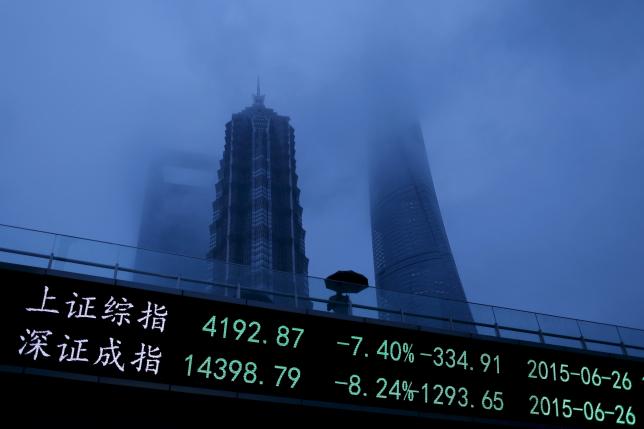Manage, meddle or magnify? China's corporate debt threat

HONG KONG - Beijing may have averted a crisis in its stock markets with heavy-handed intervention, but the world's biggest corporate debt pile - $16.1 trillion (10 trillion pounds) and rising - is a much greater threat to its slowing economy and will not be so easily managed.
Corporate China's debts, at 160 percent of GDP, are twice that of the United States, having sharply deteriorated in the past five years, a Thomson Reuters study of over 1,400 companies shows.
And the debt mountain is set to climb 77 percent to $28.8 trillion over the next five years, credit rating agency Standard & Poor's estimates.
Beijing's policy interventions affecting corporate credit have so far been mostly designed to address a different goal - supporting economic growth, which is set to fall to a 25-year low this year.
It has cut interest rates four times since November, reduced the level of reserves banks must hold and removed limits on how much of their deposits they can lend.
Though it wants more of that credit going to smaller companies and innovative areas of the economy, such measures are blunt instruments.
"When the credit taps are opened, risks rise that the money is going to 'problematic' companies or entities," said Louis Kuijs, RBS chief economist for Greater China.
China's banks made 1.28 trillion yuan ($206 billion) in new loans in June, well up on May's 900.8 billion yuan.
The effect of policy easing has been to reduce short-term interest costs, so lending for stock speculation has boomed, but there is little evidence loans are being used for profitable investment in the real economy, where long-term borrowing costs remain high, and banks are reluctant to take risks.
Manufacturers' debts are increasingly dwarfing their profits. The Thomson Reuters study found that in 2010, materials companies' debts were 2.8 times their core profit. At end-2014 they were 5.3 times. For energy companies, indebtedness has risen from 1.1 to 4.4 times core profit. For industrials, from 2.5 to 4.2.
LOW RETURNS
Gao Hong, investor relationship principal at railway equipment maker Jinxi Axle Co (600495.SH), which has seen its debt-to-core profit multiple triple to 10.25 between 2010 and 2014, said the company struggled to find profitable capital projects to invest in, so put money into short-term bank products that guaranteed returns.
"The risk for these (capital) programmes is so high and the rate of return so low that we have to make the best decision for our investors (by) purchasing bank products. Last year, we made profits thanks to the sale of CNR shares," said Gao.
Much of the new lending is going to China's notoriously inefficient state-owned enterprises (SOEs) as part of the government's fiscal stimulus.
“They are lending more to fund infrastructure projects, and some may be done by SOEs where leverage is increasing as a result," said Tao Wang, UBS head of China research.
"Prices are declining and revenue is slowing, and in this environment you cannot force too quick a deleverage – that would lead to a hard landing," said Wang.
S&P expects China's companies to account for 40 percent of the world's new corporate lending in the period through 2019.
But quantity is not the only problem.
Getting credit to the most efficient companies, where it has the most impact on the economy, would be easier if inefficient companies were allowed to fail, so markets can price debt effectively.
Policymakers have said they want market mechanisms to play a bigger role in credit pricing, but in practice have baulked at the consequences, effectively bailing out companies in trouble, as it did last year when state-backed Shanghai Chaori Solar Energy Science and Technology Co Ltd 002506.SZ defaulted on a bond coupon payment.
Rapid debt growth, opacity of risk and pricing and very high debt to GDP are a hazardous combination, Standard & Poor's says.
It took an unprecedented series of measures to arrest the plunge in China's stock markets, which are worth just over $8 trillion and are a minority pursuit for the relatively wealthy.
Tackling corporate debt might make that seem like child's play.
"Managing the debt market is probably more dangerous than the stock market because the scale of the debt market is bigger, and without any high-profile default, the moral hazard is a significant issue," said David Cui, BofA Merrill Lynch analyst. -Reuters







